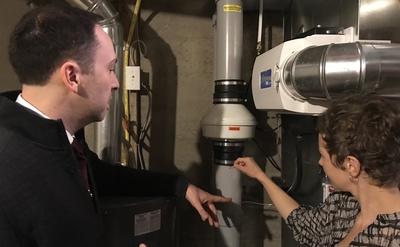
Lindsay Snodgrass shows Aaron Goodarzi the remediation piping and fan unit installed in her home.
Photo by Kelly Johnston, Cumming School of Medicine
Dec. 14, 2018

High River Mayor Craig Snodgrass and his wife, Lindsay, have lived in their High River home for 10 years. They never expected that the air they were breathing contained unacceptable levels of radon gas.
“I’d heard people talking about radon gas in Alberta, but I really didn’t give it a lot of thought until my wife wanted us to test for it,” says Craig. “Now, we’ve become advocates of testing, and I’d like to see other mayors in our province encourage their citizens to test for the gas.”
As a registered nurse, Lindsay believes in doing everything you can to prevent future illness, and with a three-year-old running around the house, testing for the gas seemed like a good idea. “I know radon is present in the air, wherever you go, but until we tested we didn’t realize how much higher the concentration of the gas was inside our home compared to outside,” she says.
Radon is a colourless, odourless gas that is naturally occurring, but can accumulate to unnaturally high and dangerous levels in homes throughout Canada. Long-term exposure to the gas is known to cause lung cancer in some people. University of Calgary research found that almost every day, an Albertan is diagnosed with a radon-related lung cancer.
Dr. Aaron Goodarzi, PhD, who is a member of the Arnie Charbonneau Cancer Institute at the Cumming School of Medicine (CSM), started the Evict Radon campaign to uncover where in our province, and what type of homes have the highest and lowest concentrations of the gas, in hopes of preventing future cancers.
“Because you can’t taste or smell the gas, many people just don’t realize the danger. In a previous study, we found one in eight Calgary-area homes had dangerous levels of the gas. Early findings from our current study indicate that in rural Alberta, one in six homes are impacted,” says Goodarzi, who is an assistant professor in the departments of biochemistry and molecular biology, and oncology at the CSM.
“We want to educate people about the effects of radon gas and encourage as many Albertans as possible to test their homes, while also gathering data for medical research.”
With the data, researchers are able to analyze why some houses have higher levels of radon than others. For instance, homes with higher square footage and taller ceilings are even more likely to have higher radon levels. There is still a lot to learn, particularly the reason why rural-area homes appear to be at even greater risk of higher radon levels than those in the cities.
Recruitment recently opened for the 2018 – 2019 winter season and while the study encompasses all of Alberta, Goodarzi’s team is hoping for more participation from rural homeowners, as well as those in the cities of Edmonton, Lethbridge, Red Deer, Fort McMurray and Medicine Hat.
The first step towards preventing cancer-causing radon exposure to yourself and your family is to have your home tested,” says Goodarzi. “Health Canada recommends mitigation for any levels higher than 200 Bq/m3. Through the study we discovered one home in rural Southern Alberta with an incredible 7,199 Bq/m3, that’s equivalent to almost 36,000 dental X-rays worth of radiation each year.” Radiation from radon is measured in a unit called the Becquerel (Bq). When measuring radon, the Bq is monitored per cubic metre of the air in your home (Bq/m3).
The mitigation of radon gas from homes is effective. In the Snodgrass family home, the level of radon gas decreased from more than 300 Bq/m3 to around 30 Bq/m3. “Mitigation cost around $3,500, but the peace of mind is priceless,” says Lindsay.
Winter is the best time to test for radon. Recruitment for the UCalgary Evict Radon study is open until Jan. 31. The radon kits used in the study cost $60. Postage is paid and each kit includes everything you need to test your home and receive your results. Your personal information is removed from the report and the results are shared with the Evict Radon research team, helping contribute to medical research and future lung cancer prevention.
Aaron Goodarzi holds the Canada Research Chair for Radiation Exposure disease. The Evict Radon study is supported by grants from Health Canada and the Alberta Real Estate Foundation. Evict Radon represents a confederation of Canadian scholars with expertise in radon biology, architecture, population health, geology and communications.

Lindsay Snodgrass shows Aaron Goodarzi the remediation piping and fan unit installed in her home.
Photo by Kelly Johnston, Cumming School of Medicine

Lindsay Snodgrass, here with her son Oren, is breathing easier after radon mitigation.
Photo by Kelly Johnston, Cumming School of Medicine